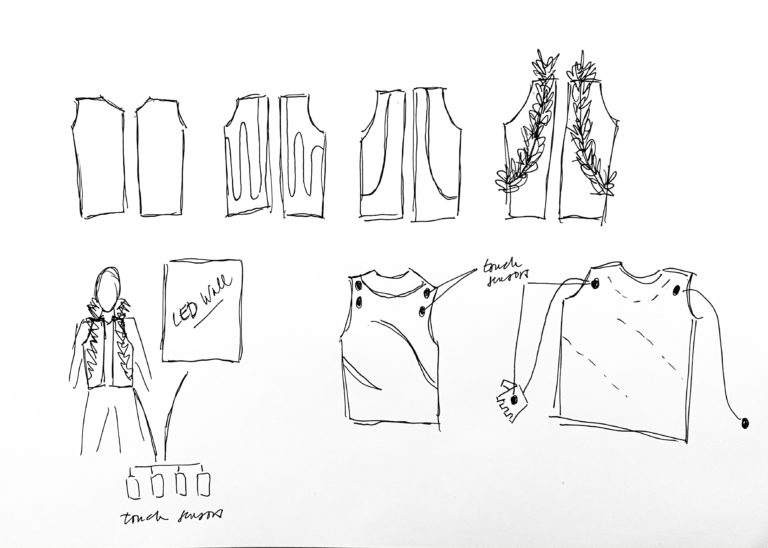tones[i]
Collaborator: Nikola Gajdosova
tones[i] is an interactive vest lined with LED strips, which changes color palettes based on the user’s interaction with a touch sensor placed on the vest’s shoulder.
tones[i] is an interactive vest lined with LED strips, which changes color palettes based on the user’s interaction with a touch sensor placed on the vest’s shoulder.
Context and Significance
For our design, we took inspiration from the song Dance Monkey by Tones and I (hence the reference in our project title), as well as this instagram account that makes custom LED costumes. We imagined this vest to be something one wears when dancing with other people at a club. Ultimately we wished to have the interaction involve a touch sensor changing colors of both the vest and an LED screen. The project is intended to enhance the nightclub experience and celebrate connection through its interactive elements.
Concept and Design
Our project had many iterations before becoming a wearable vest, and throughout all of them we kept the LED strips and touch sensors as the main materials. We used LED strips because they are both appealing to the eye and flexible in application, as they can be sewed into fabric and woven through cardboard, compared to a static 8×8 matrix LED board or individual LED pins. The LED strips proved to be incredibly successful. With the help of the FastLED library, we were able to create custom color palettes that changed based on which touch sensor was triggered. We kept the touch sensor throughout the project as we wanted to explore connection through touch. However if time allowed, we could have definitely improved our sensor selection and used copper tape to create our own touch sensors, which would give us more flexibility in their placement on the wearable vest.
Fabrication and Production
We started this project with the simple goal of creating an interactive LED board. Thus, at user testing, we showed a large cardboard wall that had laser cut holes for LED strips to go through, covered by a sheet of wax paper. We also had a touch sensor taped to a smaller piece of cardboard for users to interact with. When users touched each of four touch sensors, the color palettes of the LEDs would change, and a piezo buzzer tone would sound for each touch. Our main feedback from user testing was that: 1. we needed to diffuse the LEDs more as they were still too bright right beneath the wax paper, and 2. We needed to think more about the context of the project, as just a wall of LEDs was not interactive enough. From here, we were able to birth our idea (also thanks to Marcela) to create a wearable vest version of our circuit. Niki took the lead in fabricating the vest, and sewed the LED strips on and added the fabric on top to diffuse them. Meanwhile, I improved the code to add a fading color changing effect.
We also improved our LED board by creating a 1.5 inch border around the cardboard so that the wax paper was further away from the LEDs. This way, the LEDs were significantly more diffused and created more of an ambient lighting effect behind our wearable vest.



Conclusion
Our goal for “tones[i]” was to create an interactive vest that improves the nightclub experience. I think we succeeded in the interactive aspect, as the touch sensor is where the user provides input, which is then processed as different color palettes (output). Furthermore, “tones[i]” started off about connection, but its presentation in class became more of a performance, in that Niki and I demonstrated how it would work, while the audience’s main role was as spectators on the side. Because we were in a classroom setting and I was wearing the vest in the project demo, perhaps people weren’t as comfortable coming up to touch my shoulder, but after we put the vest back on the figurine I noticed a lot of people go up to play with the vest on their own. I think the LEDs behind the intricate fabric diffusion are what drew the audience in, in addition to the touch sensor interactive aspect.
If we had more time, I would explore using copper tape to create our own grid of touch sensors, or experiment with a tilt sensor or motion sensor to make the LEDs react to different movements. Additionally, I would improve the user experience by adding a battery pack to the LEDs so that the vest could be portable and classmates could try it on. I would also consider improving the user experience by putting the touch sensors under a different color fabric. Lastly, I would switch to an Arduino Mega board so that the circuit could handle 300+ LEDs without running into memory issues.
This was my first time working on an official project involving hardware. The entire process was incredibly thought-provoking and it was very fun to bring our ideas to life. From this project, I definitely learned how the design of various components influences the user experience and response to the project, which I hope to be more mindful of in future projects.

